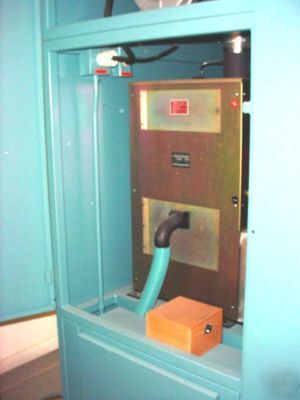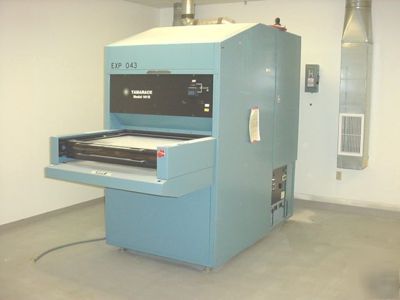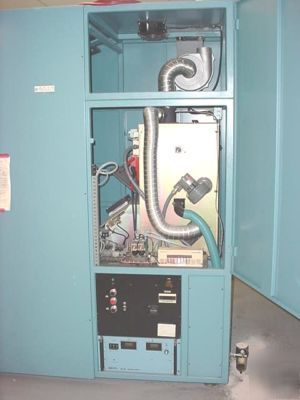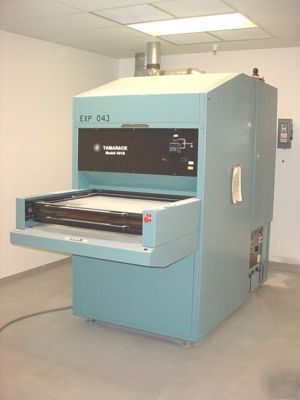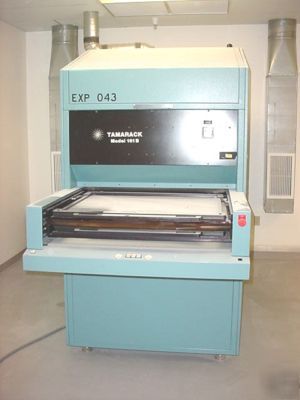EXCLUSIVE FORUM FOR MACHINE DISMANTLERS AND REPAIR PEOPLE > Hammond
> Light Machinery
> Wheels
> Tamarack 161B printed circuit board exposure system
Tamarack 161B printed circuit board exposure system
Tamarack Printed Circuit Board Exposure System
Overall Equipment Description:
The 161B is a semi-automatic machine, used to provide rapid and precise alignment of large printed circuit board panels with respect to artwork and to control panel exposures.
Major components of the 161B are as follows:
1) Panel alignment / exposure station
The major components of the 161B are described in more detail in the paragraphs which follow.
The alignment / exposure station provides the facilities for aligning the P.C.B. panel with respect to the artwork and providing vacuum contact for exposure.
The mylar cover frame is hinged toward the rear of the machine to allow raising of the frame for changing the panel and artwork.
The collimated illuminator provides a condensed beam of ultra-violet light of uniform intensity for use in exposing the panel. The shutter within the illuminator opens for a preset interval to accomplish the exposure. Two modes of exposure control are available to operate the shutter: constant time and constant energy. Constant time is set in on the exposure time in seconds. In the constant energy mode, exposure energy in millijoules per centimeter squared (mJ / cm) is set on the exposure energy thumbpot.
The light source for the collimated illuminator is a high pressure mercury arc lamp mounted in a forced air cooled housing. Because of the explosion hazard associated with this type of light source, even when properly maintained, the housing is designed to contain and withstand lamp explosion.
The lamp is positioned near the first focus of an ellipsoidal reflector. Three thumbscrews provide the means of moving the lamp along the X, Y, and Z axes in order to obtain the proper lamp position.
The ellipsoidal reflector directs the reflected light toward a distant second focus thus avoiding the possibility of lamp damage due to reflection of energy onto critical parts of the lamp. The ultra-violet light from the ellipsoidal reflector is turned twice to reach a second focus located at the lenticular integrator. The dichroic mirrors which turn the ultra-violet light pass most visible light and infra-red energy which are thus dissipated as heat within the lamp house and exhausted out of the system.
The lenticular integrator, located at the second focus of the ellipsoidal reflector, collects the ultra-violet energy and directs it toward the collimating mirror in such a manner as to approximate a point source of light. The mirror collimates the light from the integrator so as to form a beam of light exhibiting uniform intensity over its beam width.
A shutter which controls panel exposure is located just ahead of the lenticular integrator. An associated panel switch provides the means of holding this shutter open for the purpose of lamp intensity and focus adjustments or placing it under the control of the digital timer or integrating exposure controller during panel exposure.
The pneumatic panel is located inside the machine above the side control panel. This panel supplies air pressure and vacuum to all air operated systems through the machine. The solenoid valves are operated on 24V DC and controlled from the sequencer and pushbuttons.
Control of the 161B is accomplished by a Mitsubishi programmable controller located on the pneumatic panel. The manual switch panel is also mounted on the pneumatic panel.
The side control panel is used to start and stop all functions of the machine.
1) Main power contactor enable
3) Lamp exhaust temperature, alarm and lamp meter (resettable)
The timer and integrating exposure control switch are used to pick the mode of exposure. If the machine is used in the time mode, the exposure time in seconds must be set. When constant exposure energy is required, the IEC will measure the quantity of energy at the panel / exposure plane and control the shutter to maintain the same exposure energy independent of light intensity.
The bullnose contains a light table to aid alignment of the artwork to the substrate. The start cycle switches must be actuated simultaneously to begin print drawer movement. Top and bottom vacuum switches, gauges, emergency off switch and final cycle switches are also on the bullnose.
Unit currently in production area. Manufacturer is no longer in production at this facility. EXCELLENT CONDITION
